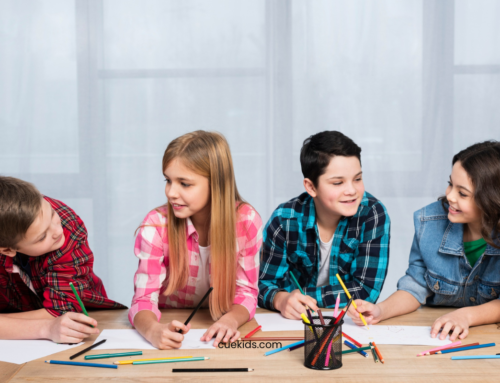Have you ever noticed, when two children play on the playground with a ball, suddenly one of them snatches the ball while the other one simply hands over the ball to his friend? Here one of the two wants to take the ball, maybe he is afraid of losing it, and the other wants to offer the ball thinking he also wants to play with it. We all use different views while sharing our thoughts with someone in our daily life. To convey our emotions we use different ways. Such as writing down, maybe talking to close friends, watching comedy, engaging shows or movies, or just reading a book or poem on something. There is one poem that I came across while doing some internet research.
IF YOU WERE I….
Carol S. Lidz
If you were I And I were you,
What in the world Do you think we’d do?
What would we say? What would we be?
If I were you And you were me?
It is quite an easy-to-understand poem. The lines suggest how we change our perspectives while talking, sharing, and understanding each other. It shows us what we think about people and how we put ourselves in their shoes. Perspective-taking gives us to think and makes us aware of another person’s needs and wants of the family, friends, and social groups. Children also need to learn perspective-taking as it is a valuable skill. Learning this skill can help them develop body language as well as social communication.
Perspective-taking: A useful tool for children:
- Perspective-taking is the ability to develop social awareness and think critically about social situations. It is an essential skill for children that allows them to see beyond their point of view and teaches them to consider how others might think or feel.
- Children who have less perspective ability can become inconsiderate and impolite with their peers. They can start to believe that their perspective was always correct.
- It can result in children dismissing others’ thoughts and feelings that differ from their own.
- Learning about perspective-taking can help them build cognitive and attention skills. It can improve kids’ self-awareness, social experiences, and interactions. They can learn to communicate and express themselves more effectively using this tool.
- Role-taking can also help children acknowledge how people’s actions and motivations affect their behaviors. They can learn to interact with others as a group to build their body language and skills.
Read: Can Kids Read Body Language?
Perspective-taking helps children develop non-verbal communication:
- At an early age, children start to identify if their playmates are upset or sad. They can recognize various non-verbal cues such as the kid’s facial expressions, tone of voice, and body language. Here, parents can talk to children about why the kid is upset and ask them for ways to feel better about themselves.
- They started to observe how others behave and think. Using stories to express feelings can help children understand and relate their experiences. Parents can ask children why characters in the story felt or acted a certain way.
- Stories with different characters may also help children think or see from a different perspective. Parents can talk to their children about body language and expressions and how to interpret their feelings.
- A study shows that 8 years old were able to effectively adjust their behavior by using the information offered by their partner’s facial cues.
- Along with making mastery of perspective-taking, children can develop competitive experience and ongoing cognitive development using non-verbal skills. It can help them communicate better in social interactions.
Learn about Role-taking and social development strategies:
- Role-taking is an essential social skill for early childhood development. Along with verbal and physical abilities, children can learn social and emotional cues through role-taking.
- It is a sub-concept under the term social cognition. Children’s early progress involves social-cognitive development.
- It includes their beliefs, thoughts, desires, and emotions about social groups and situations.
- They must learn prosocial behaviors such as sharing, working together, and helping someone in distress. Children with poor prosocial activity may appear angry, say hurtful things to friends, seize their stuff, and refuse to join or sit near them.
- They should learn how to share, adjust, and interact with their peers. Learning about role-taking can help children understand their language and social skills. It can build positive relations with their friends.
Read: Importance of Social Skills Your Child Should Learn Early On in Life

Tips for parents to teach perspective-taking to kids:
- Parents can ask their children about why other people think and act differently. They can talk about how people understand each person’s thoughts, ideas, actions, and motives in a social event.
- For example, if one of the two peers only has fruit in his lunch box for lunch break, his friend immediately offers to share his lunch with him. Here, parents can ask a child: “Why do you think your friend couldn’t bring a proper lunch to school today?”
- By doing this, children can start to think there is often more than one side to the story and can answer, “Maybe he was in a hurry for the school bus, or maybe his mom was unwell or was not at home.”
- Such discussions can help kids develop various perspectives on resolving conflict, developing empathy, making decisions, and interpreting others’ motivations and needs.
- Parents can use Role-play and narration to help kids to explore others’ perspectives through first-person point of view to speak in proper tone and manner in a peer group
- Encourage children to think of the pros and cons of different choices and actions in an event. Parents and children can exchange opinions while discussing topics to look at an issue from different angles without going to extreme.
Let’s Learn about building Social skills for children at different ages:
Early childhood development is a very crucial part of a child’s growth. They began learning from their parents, teachers, and elders at a young age. They also adapt certain viewpoints from their surroundings to build their body language and social communication. These viewpoints can be explained through Robert Selman’s five levels of perspective-taking abilities in early childhood stages.
- Level 0: here, children aged 3-6 used undistinguished perspective-taking. They could not recognize that others have feelings, thoughts, and views different from theirs.
- Level 1: kids aged 5-9 develop social-informational perspective-taking. They start to realize that others have different feelings but are unable to consider them.
- Level 2: Children from the 7-12 age group have the self-analytical role-taking ability. They begin to consider themselves as well as others’ ideas and feelings.
- Level 3: kids in age 10-15 can build third-party perspectives. They try to understand their friend’s feelings and behaviors.
- Level 4: In this stage, children turn into teenage 14-adults, and they acquire societal viewpoints. It can increase their ability to predict, understand and cooperate with others’ perspectives.
Conclusion: To sum up, in the early childhood stages, parents can encourage kids to interact using prosocial activities. They can develop their interest in perspective-taking and social skills. Kids can learn to talk and respect others’ feelings. They can begin to work together, collaborate and adjust with their peers. It can also help them build non-verbal and social communication.
Know about our Social Skills Course for Kids
Reference:
Drupadi Rizky, The Effects of Perspective-Taking on Prosocial Behavior in Early Childhood, 2019, Atlantis Press, https://www.atlantis-press.com/proceedings/ecep-19/125943193
Lidz s. Carol, Poems for Young Children, Book, January 2011,
https://www.researchgate.net/publication/275465448
Smith Rachelle, Development of Children’s Ability To Infer Intentions from Nonverbal Cues,2009, Journal of Social, Evolutionary, and Cultural Psychology,
https://psycnet.apa.org/fulltext/2011-15660-004
Web Sources:
https://www.mindinthemaking.org/perspective-taking
https://www.tsv.catholic.edu.au/the-importance-of-perspective-taking-for-social-development
https://www.canr.msu.edu/news/the_importance_of_perspective_taking_for_young_children
https://www.child-encyclopedia.com/social-cognition
https://engagingpeace.com/?p=1383






Leave A Comment